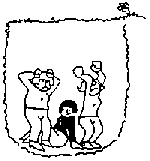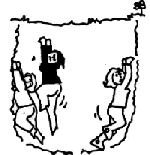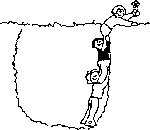
|

|

|
Once
upon a time,
there were some people stuck in a pit… |
They
tried to fly out
by flapping their arms… |
They
tried jumping … |
|
|
|

|

|

|
They
tried mediation
and levitation… |
They
even tried
climbing the walls… |
This
went on for years and years until
they had tried everything except
helping each other out… |
|

|
|
|
So
they helped each other out! |
|
|
|
   |
   |
 |
|
As for the two donkeys, winning entries for captions have included:
'Cooperating is better than competition.' "Pull together or we'll get pulled
apart."
'If you're going to be an ass about it, well all starve!"
Finally, caricature of what not to do can enhance our appreciation of network attitude.
Here is an example, contributed by Connie Hyatt of the Oregon State Department of Human
Resources. Her network-averse types are oriented some what towards volunteer programs in
agencies, rather than all-volunteer groups. But the overall relevance is crystal clear.
"Turf Ogre": A person with insecurities who needs to
control. Turf Ogres can be found dominating meetings, identifying (other's) successful
projects by the pronoun we, hiding names of volunteers, never mentioning funding sources,
looking after #1, and in general being difficult. Turf Ogres fear the 'pirating away"
of volunteers more than any other calamity they can imagine. They en- counter great
difficulty dealing with volunteers who do not see themselves as slaves.
"Co-Opter": A person with a silky smile and an overly
agreeable nature. Co-opting is a very effective way to neutralize the competition.
Co-opters want to own people and are, in general, immature, insecure and lacking in a
sense of professionalism. A Co-Opter "assimilates" the competition by including
them as members, making their activity a part of her/his newsletter, making sure that the
competition is always invited to recognition events and receives a reward if possible. In
these ways, a Co-Opter will destroy the competition's ability to relate to anybody else.
Co-Opters encounter great difficulty with networks, democracy, the vote, adults, etc.
(Watch out you don't wake up and find yourself in their network, never knowing -how it
happened.)
"The Lone Arranger": A person with the "only I can do
it" martyr syndrome. Lone Arrangers can be found working late, reassuring the world
that only their agency is helping resolve a problem (mainly because they won't let anyone
else help), heaving sighs of fatigue while volunteering to take on added tasks, suffering
burnout while making sure that no- body can rescue them and generally seeking lots of
sympathy. The word 'delegation' is frightening to a Lone Arranger.
((((Connie Hyatt, quoted in Susan Dryovage and Ivan Scheier, 'The Bridge: A Guide for
Networkers" (Boulder, CO: Yellowfire Press, 1981)))))
People can be asked to give examples from their experience of these three anti-network
types-and perhaps add some others as well (though three are quite enough!). We're not
trying to advocate here that people such as these must be excluded entirely from our net-
works. Rather, we're trying to recognize that there is a little of each type in all of us
and understanding this is the first step in improving our networking performance.
Finally, the 'Code of Behavior for Networkers" on the next page is a humorous
endorsement of pro-network attitudes.
Having Simple Rules
The first network-facilitation strategies I devised were elaborations of what I'd seen
successful networkers actually doing. These elaborations didn't work, usually. Apparently
people in real-life situations don't ordinarily need complex procedures for doing what
comes naturally. What they need, it seems, are simple but powerful rules and principles.
These are more like triggers for releasing mutual aid energy than channels for restricting
it.
I rest my case on your experience with the following network exercises.
And I wish you luck with your non-staffed volunteer group. Beyond luck, I wish you
understanding, which means success.
CODE OF BEHAVIOR ... FOR
NETWORKING
BE COWARDLY. Sure, there may be some deep rough problems between you.
Stay away from them, in fact, avoid them like the plague. Go for the easier issues first
and get some successes under your belt. Save the bravery for later, when everyone is
feeling good about how well the cooperation is working.
BE SHORT-SIGHTED. It's not just that you want to load the dice for
some sure successes early on. You also want those to be quick payoffs. People are probably
wondering whether this try at network cooperation is ever going to work at all. In that
frame of mind, they won't wait in line too long for the first positive results. So make
the motivation happen fast.
BE A BUSYBODY. Be nosy about other people's business. At least, until
you're sure you understand their strengths well enough to capitalize on them. Be just as
sure to learn their no-no's so you can avoid their aversions.
BE SELFISH. Ask if there's something in it for you and be darn sure
you get the right answers.
BE A SUCKER. Once you're sure there's something in it for you, worry a
little about whether other people are getting their goodies from the network. Go ahead, be
a bleeding heart.
BE DISTRUSTFUL. Look for performance, not promises, deeds not Words.
...and above all
BE DISRESPECTFUL, of the notion that all help has to be delivered down
to us by highly trained specialists. Believe instead that ordinary people and groups can
give each other a whole lot of real help, without always having to call in the outside
experts.
Think you can measure up?
Maybe you can even add to the list, or turn it around to positive characteristics. Go
ahead, be critical.
-NETWORKING EXERCISES AND INITIATORS
The following is a small sample of methods for creating and strengthening networks. All
were stolen from successful networkers observed over the years; I've only tried to impose
analysis on what expresses itself more naturally and spontaneously in real life. As for
the wonderful 'style" one sees so often in the brilliant networker, I doubt this can
ever be reduced to 'steps" and I haven't even tried to.
Earlier versions of these exercises appeared in a series of Yellowfire Press
publications, now out of print.
The following processes can be used as training exercises. As such, they are often
incorporated illustratively with the general orientation described in Chapter 7. The
methods can serve equally as 'triggers" or initiators for actual networks. Only be
sure to tell participants clearly-and up front-which use is intended.
Relatively simple and easy exercises tend to be placed earlier in this section.
Otherwise, order of presentation has no particular significance.
When Everyone's a Volunteer by Ivan Scheier is available for
purchase from Energize. |